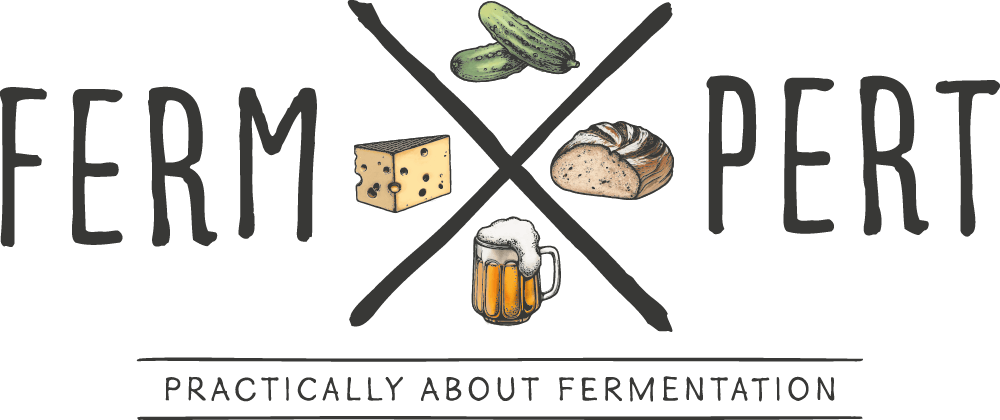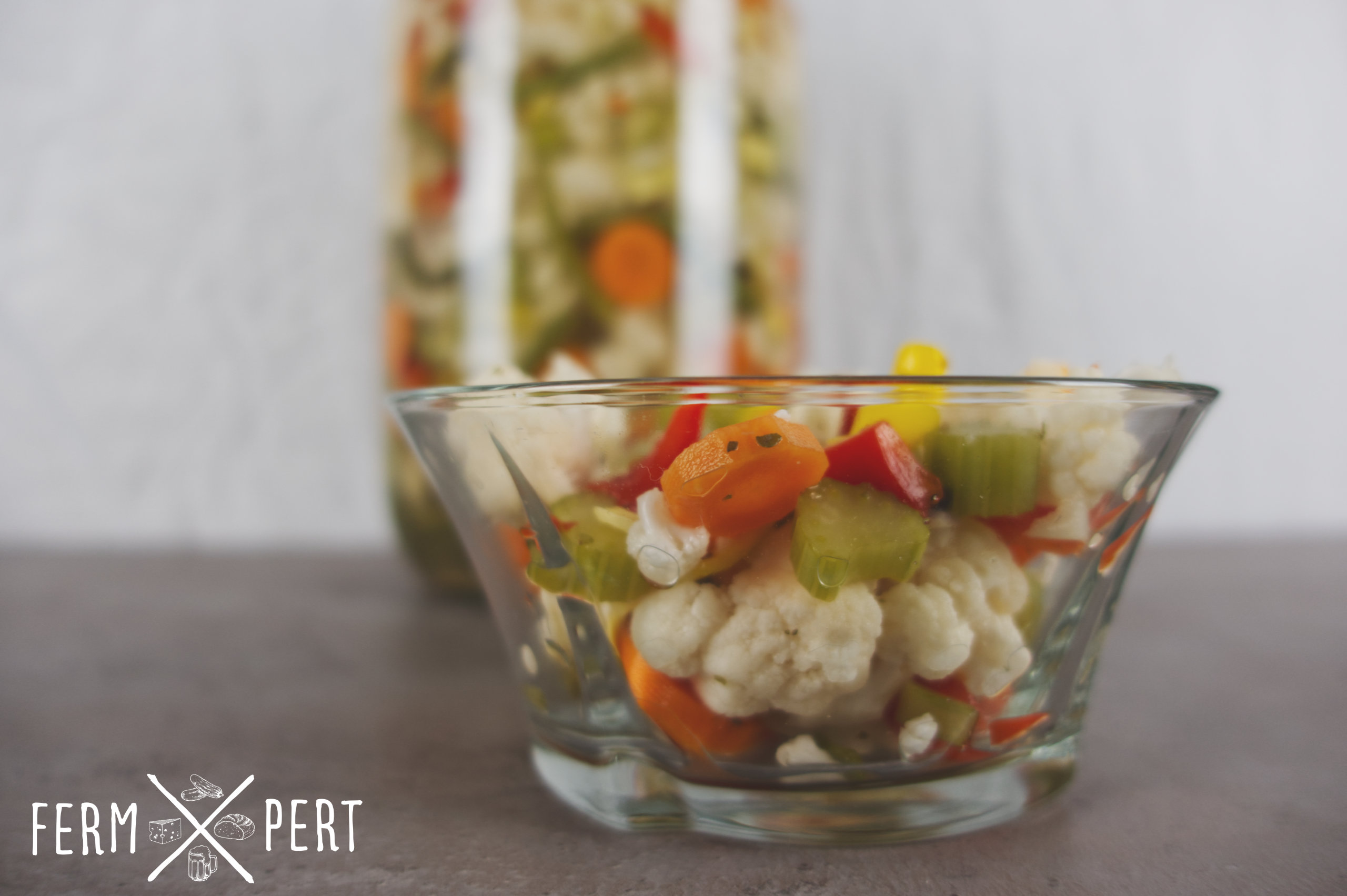Giardiniera originates from Italy, though it’s arguably the most popular in Chicago, where it’s a common addition to multiple dishes. In its classic form, it uses vinegar to pickle the vegetables, but I’ve always prepared it my way, leveraging lactic acid fermentation.
Recipe
- 1/2 cauliflower head
- 2 medium sized onions
- 4 garlic cloves
- 3 carrots
- 2 red bell peppers
- handful of spicy peppers (to taste)
- 3 celery sticks
- 10 cm (4 in.) piece of leek
- 1 tbsp. black peppercorns
- 1 tbsp. coriander seeds
- 1 tbsp. white mustard seeds
- 1 tbsp. dried oregano
- 6-8 bay leaves
- water
- salt
The proportions of the vegetables are not set in stone. They can be adjusted to personal preferences. Adding and removing them is also fine. A classic giardiniera contains cauliflower, celery, bell pepper, carrot and gherkins (which I’m not using). It’s possible to add other ingredients, such as olives.
The salt brine should have a 2-3% salinity. In other words, in 1000 grams of brine, there’s 980 g water and 20 g salt (or 970 and 30 g for a 3% brine). It’s the easiest to dissolve the salt in warm water, but it shouldn’t be hot.
Cut the vegetables into pieces that can easily be picked up with a fork. Place them in a large jar (at least 4 litres, or 1 qt., and preferably slightly more) along with the herbs and spices. Pour brine over the vegetables so that it covers everything. Should any ingredients float, remove them in order to prevent mould. Screw the jar’s lid loosely so that the released carbon dioxide can escape. Leave in room temperature, away from direct sunlight.
Giardiniera is ready to eat after just two days, though it’s also OK to let it ferment all the way through, which should take around two weeks. Store in the fridge. It should keep for at least a month.
Video Transcription
Giardiniera originates from Italy, but due to migration, it has spread to other countries. It’s popular in Chicago. In its original form, giardiniera is a vinegar pickled mix of vegetables. An oil variety is also common. However, I’m going to give it a twist and use lactic fermentation. The recipe is available on the blog.
The ingredients list is rather long, though some vegetables can be swapped or removed completely. I will be using cauliflower, carrots, peppers, both sweet and spicy, celery, green beans, onions, leek and garlic. The herbs and spices include oregano, mustard seeds, black peppercorns, coriander seeds and bay leaves.
I begin by preparing the cauliflower. I only need about half a head, so I cut off several large fleurettes. Then I proceed to divide them into smaller bits.
I peel a few carrots. I line them up and slice them. I go for thick slices.
Next on the list are bell peppers. I core and seed them. Then I cut them up into nice, medium sized chunks.
I also use a few spicy peppers. Normally these would be a couple chillies, maybe some jalapeños. This time though I happen to have harvested a handful of Peruvian ají limón peppers, also known as lemon drop chillies, so I go with them. I remove the stems and slice the peppers thinly. I leave the seeds in for the extra spiciness they provide.
The heat in spicy peppers comes from capsaicinoids, mostly capsaicin and dihydrocapsaicin. The lemon drop variety, although nowhere near the top of the list of spiciest peppers, contains a decent amount of capsaicinoids, a few times more than a jalapeño.
Celery sticks are next in the queue. I simply slice them, pretty much the same way I did the carrots.
I remove the stems from green bean pods. Next, I cut them in half. Shorter pieces are more manageable than whole pods.
I peel a few cloves of garlic. Since I don’t add much compared to the volume of the remaining ingredients, I slice the garlic relatively thinly.
I peel and dice a few onions. Working with onions always makes my eyes water. This is due to sulfuric acid forming on the eyeballs.
The onions have a defence mechanism against pests. When its cells are damaged, they release sulfenic acid and an enzyme, alliinase, that converts the acid into an irritant, syn-propanethial S-oxide. It is volatile and quickly rises up, eventually touching the eyeballs. There, in contact with water, it turns into sulfuric acid, a potent lachrymatory agent. The eyes produce tears to flush the acid out.
I cut a sizable piece of leek. Then, I cut it lengthwise. Finally, I slice both halves, again, similarly to the carrots.
Now it’s time to mix the vegetables. The bowl is pretty full, so I choose to toss the contents until they’re evenly distributed.
I use the largest jar I have at my disposal. I start by adding herbs and spices. Their job is not just to boost the aroma and flavour, but also to provide a bit of tannins. They will make the vegetables lose their crunch at a slightly slower rate. Coriander seeds go in, then black peppercorns, mustard seeds, bay leaves and oregano.
I proceed to place the vegetables in the jar. When it’s half full, I add the herbs and spices again. Then I continue filling it with the remaining vegetables. More herbs and spices go near the top of the jar. Finally, one last layer of vegetables. I need to press them down a bit in order to squeeze them all in.
I prepare a bowl of warm water that will serve as a base for my salt brine. I could have calculated the exact amount of brine needed by filling the jar, draining it and weighing the water, but this time I just eyeballed the amount. I add salt to produce a brine with 2.5% salinity. I stir until the salt has dissolved completely. Then I pour it into the jar. On top, I add a fermentation weight. It’s a bit small, but I don’t have a larger one that will fit into this somewhat overfilled jar. Some vegetable pieces float to the top and I do my best to remove them.
Finally, I screw on the lid, but not too tightly. Fermentation isn’t very vigorous in case of giardiniera, but some carbon dioxide will still be released. Now I leave the jar to the microbes. It will be around two weeks until fermentation is complete, but I like my giardiniera half-sour. I think it’s good to eat after two days.
During the fermentation, lactic acid bacteria, such as Leuconostoc mesenteriodes, Lactobacillus brevis and Lactiplantibacillus plantarum, consume the carbohydrates present in the vegetables. They excrete carbon dioxide and lactic acid, which acts as a preservative and a flavouring agent. It also reacts with chlorophyll contained in the green vegetables, converting it into phaeophytin and making the veg change colour to an olive green.
I open the jar after two days. There are visible carbon dioxide bubbles. I typically use a small slotted spoon to get the veg out. The aroma is very pleasant. Lactic acid is perceivable, as well as some of the more fragrant vegetables, but the oregano is clearly coming through too, giving the giardiniera a unique character.
The flavour is excellent. Rich, mostly sour, but still with some residual sweetness and of course a bit of a fiery kick from the chillies. There’s a variety of textures too: the cauliflower and the celery are very crunchy, the carrots and the green beans less so, and the peppers are nice and soft already. Delicious.
I will place it in the fridge, where it can stay safely for many weeks. I’ll eat it as a standalone snack, as a side dish or as a salad ingredient. When chopped up, the giardiniera will serve as a lovely relish for my sandwiches and burgers.

